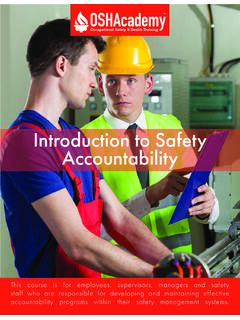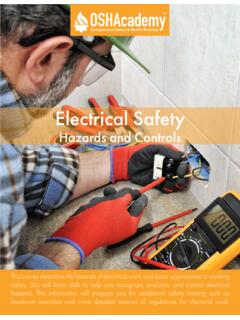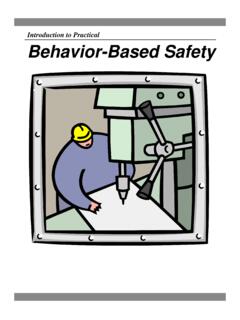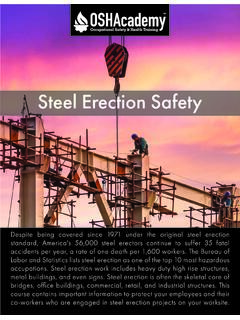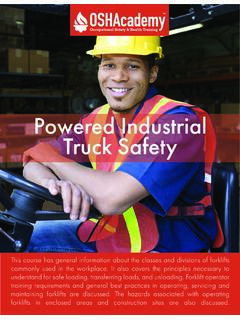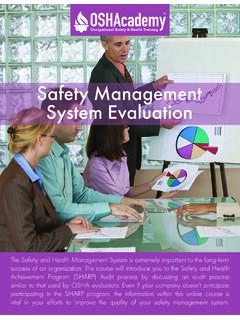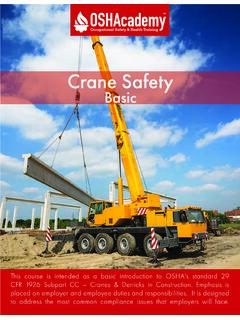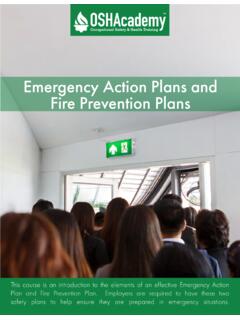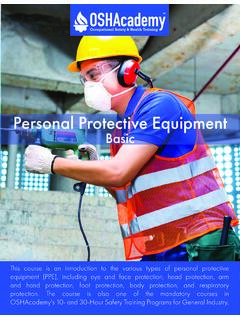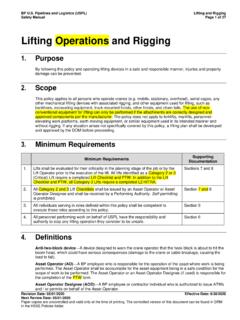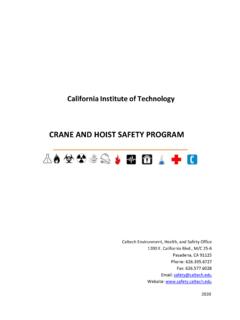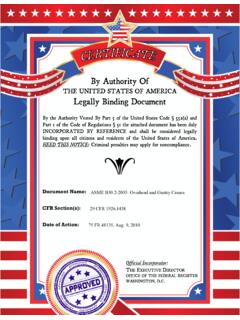Transcription of EM 385-1-1 30 Nov 14 Section 14 TABLE OF ... - OSHAcademy
1 EM 385-1-1 EM 385-1-1 . 30 Nov 14 30 Nov 14. Section 14. TABLE OF CONTENTS. Material Handling, Storage and Disposal Section : Page Material Handling .. 14-1. Material hoists .. 14-2. Material Storage .. 14-4. Housekeeping .. 14-7. Debris Nets .. 14-8. Material Disposal .. 14-8. 14-i EM 385-1-1 EM 385-1-1 . 30 Nov 14 30 Nov 14. THIS PAGE INTENTIONALLY LEFT BLANK. 14-i EM 385-1-1 EM 385-1-1 . 30 Nov 14 30 Nov 14. Section 14. Material Handling, Storage and Disposal Material Handling. Employees shall be trained in and shall use safe lifting techniques. > See Section Requirements for PPE are covered in Section 5. Material handling devices shall be available and used for the material handling needs of an activity.
2 Whenever heavy or bulky material is to be moved, the material handling needs shall be evaluated in terms of weight, size, distance, and path of movement. The following hierarchy shall be followed in selecting a means for material handling: a. Elimination of material handling needs via engineering solutions;. b. Movement by mechanical device ( , lift truck, overhead crane, or conveyor);. c. Movement by manual means with handling aid ( , dollie or cart); or d. Movement using safe lifting techniques. > See NIOSH, Work Practices Guide for Manual Lifting . Materials will not be moved over or suspended above personnel unless positive precautions have been taken to protect the personnel from falling objects.
3 Where the movement of materials may be hazardous to persons, taglines or other devices shall be used to control the loads being handled by hoisting equipment. These devices shall be nonconductive when used near energized lines. Banding or strapping shall not be used as rigging to hoist loads of bundled materials. 14-1. EM 385-1-1 EM 385-1-1 . 30 Nov 14 30 Nov 14. Material hoists . Material hoists shall be designed to raise and lower materials during construction, alteration, or demolition. It is not applicable to the temporary use of permanently installed elevators used as material hoists . They shall be constructed and installed in accordance with the requirements of ANSI Material hoist towers, masts, guy or braces, counterweights, drive machinery supports, sheave supports, platforms, supporting structures, and accessories shall be designed by a licensed engineer.
4 Hoist towers shall be erected and dismantled only under the direct supervision of a qualified individual. A copy of the hoist operating manual shall be available for each hoist on site. Material hoists and hoist tower systems shall be inspected in accordance with the manufacturer's recommendations. a. Prior to initial use and each time after the tower is extended, all parts of the tower or mast, cage, bucket, boom, platform, hoisting machine, guy, and other equipment shall be inspected by a Qualified Person (QP) to ensure compliance with the manufacturer's inspection guidelines and ANSI b. Prior to initial use on a USACE project, and monthly thereafter, a periodic inspection shall be conducted by a QP.
5 Periodic inspections shall cover those items specified by the manufacturer. c. A GDA shall be notified at least 24 hours prior to any of the above inspections and may wish to accompany the contractor's inspector. d. Pre-operational inspections (start-up procedures) shall be conducted by the operator prior to every operation (shift) of the hoist. Before a hoist is placed in service and every 4 months thereafter, a car arresting device test shall be performed. a. For rope-supported cars, the test shall be conducted in the following manner: (1) Pull a loop in the lifting rope and attach the test rope to each side of the loop above the bucket or platform.
6 (2) Raise the platform or bucket to allow the load to be supported by the test rope; and 14-2. EM 385-1-1 EM 385-1-1 . 30 Nov 14 30 Nov 14. (3) Cut the test rope to allow the load to fall and activate the car-arresting device. b. For car suspension other than rope supported, the test shall be conducted by creating an over speed condition of the car. c. Structural components shall be inspected for damage after the test and before the hoist is placed in operation again. Maintenance and repairs. a. Replacement parts for load bearing or critical components shall be either obtained from or certified by the equipment manufacturer. b. Maintenance and repairs shall be conducted in accordance with the manufacturer's procedures.
7 Landings and runways. a. Landing platforms and runways that connect the hoist way or tower to a structure shall be designed and constructed to sustain the maximum intended load without failure. b. Floors or platforms that may become slippery shall have slip-resistant surfaces. c. When workers may be exposed to falling objects, overhead protection, composed of 2 in (5 cm) planking or equivalent, shall be provided. d. A barricade shall be provided at the open ends of each landing. The barricade shall extend a minimum distance of 6 ft ( m) laterally along the outer edge of the landing from each side of the hoist way, shall extend from the floor a distance of at least 3 ft ( m), and shall be of #19 US gauge wire or the equivalent, with openings not exceeding -in ( cm).
8 E. All hoist way entrances shall be protected by substantial gates or bars that shall guard the full width of the landing entrance. Gates shall be not less than 66 in ( cm). in height, with a maximum under clearance of 2 in (5 cm), and shall be located not more than 4 in (10 cm) from the hoist way line. Gates of grille, lattice, or other open work shall have openings of not more than 2 in (5 cm). f. Material shall not be stored on landing platforms or runways. Whenever a slack line condition occurs, the proper seating of the rope in the sheaves and on the drum shall be checked prior to further operations. 14-3. EM 385-1-1 EM 385-1-1 . 30 Nov 14 30 Nov 14.
9 Riding on material hoists or other hoisting equipment not meant for personnel handling is prohibited. While hoisting equipment is in operation, the operator shall not perform any other work and shall not leave his/her position at the controls until the load has been safely landed or returned to ground level. Not more than one cage or bucket shall be operated at the same time by any one hoisting machine or operator. Operating rules shall be established and posted at the operator's station of the hoist. Such rules shall include signal system and allowable line speed for various loads. Rules and notices shall be posted on the car frame or crosshead in a conspicuous location, including the statement "NO RIDERS ALLOWED.
10 ". Air-powered hoists shall be connected to an air supply of sufficient capacity and pressure to safely operate the hoist. Pneumatic hoses shall be secured by some positive means to prevent accidental disconnection. Material Storage. All material in bags, containers, bundles, or stored in tiers shall be stacked, blocked, interlocked, and limited in height so that it is stable and secured against sliding or collapse. a. Material shall be stacked as low as practical and in no case higher than 20 ft (6 m). unless otherwise specified in this Section . b. Storage of flammable and combustible materials is covered in Section 9. c. Storage of hazardous and toxic agents is covered in Section 6.
